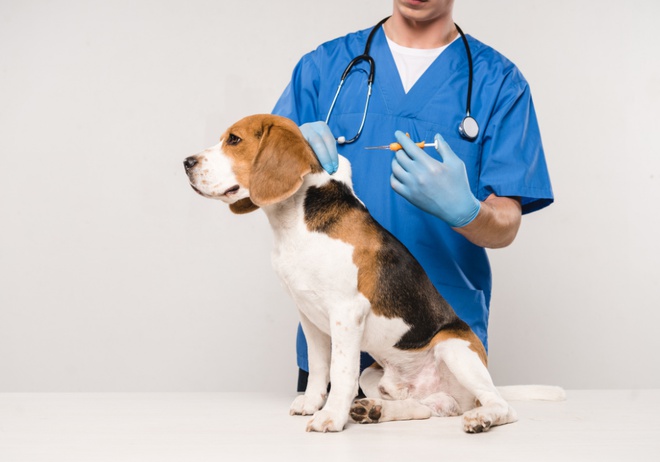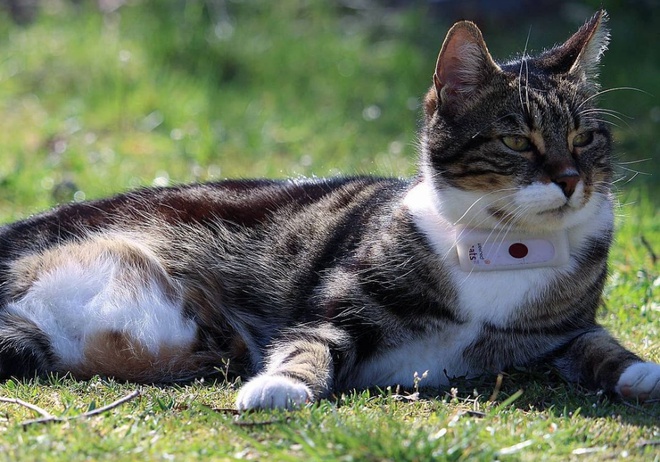Identification is a major step in your pet's life. Here are the key things you need to know to make sure everything goes smoothly.

Reading time : 7 min
This guide will help you learn more about microchips.
It is designed to cover all the main aspects of microchipping, from the cost of the microchip, to changing the information on the chip, to a practical explanation of microchipping.
Microchips may seem complex, but they are actually easy to understand. The more you know about microchips, the more reassured you will be when you visit the vet.
Microchipping a pet is a quick and simple procedure. The chip is inserted under the pet’s skin, between the shoulder blades, using a needle. It only takes a few seconds.
A pet microchip is a tiny computer chip that’s roughly the size of a grain of rice. It carries a unique identification number that matches up to your pet’s details. The chip contains information about the animal and its owner. In fact, a microchip acts like the pet’s identity card.
A handheld electronic device, called a scanner, can be used to check the pet’s microchip and to find the information about the pet and its owner.
It is legitimate to start by asking yourself whether it is useful to have your pet identified. There are at least 4 good reasons to have your dog or cat microchipped.
In recent years, English law has increased the requirements for animal identification. Since April 2016 it has been compulsory to have all dogs chipped. This law does not apply to cats, but it is strongly recommended.
It is necessary for your pet to be microchipped if you wish to travel with it. Indeed, microchipping is now a prerequisite for travel to other countries. Make sure your pet’s microchip meets ISO standards so that it can be scanned by any type of scanner.
There are particular cases in life where it is necessary to be able to prove who the legal owner of the animal is. For example, if a dog or cat is stolen, if a divorce occurs, or if a family has taken in an animal they thought was lost.
There is nothing more terrible than having to give up your beloved pet simply because you cannot prove that you are its owner. It is therefore necessary to have your ownership legally recognised. To do this, there is no other choice than to have your cat or dog chipped (or tattooed). This identification will allow the competent authorities to confirm that you are the owner of the animal.
If your dog or cat is missing, its identification number will be the only way for people who find it to contact you, and thus return it to you. This can save many days of anxiety and worry. Because as soon as your pet is brought to a shelter or a veterinary clinic, authorised persons will be able to read the information linked to its identification number. You will be contacted within a few minutes and given an appointment to come and collect your pet.
Click on the title of the chapter you are interested in.
Chapter 1: What is microchipping?
Learn what microchipping is, what a microchip looks like and how it works.
Chapter 2: How to microchip?
This chapter explains who can microchip your pet and what your responsibilities are as an owner.
Chapter 3: How to read a pet microchip?
If you find a lost pet, you will probably need to check if it is microchipped so that you can return the animal to its owner.
Chapter 4: How to change pet microchip details?
If you don’t keep your contact details up to date, the chip implant will be useless. This chapter covers the steps to take if you want to change your contact details and the cost of doing so.
Chapter 5: How much does it cost to microchip a dog or a cat?
The fifth chapter will discuss the cost of microchipping and why some owners are reluctant to microchip their pet.
Chapter 6: Implant or GPS chip for cats and dogs, how to choose?
Learn what the difference is between a GPS chip and a microchip and how to choose the right tracking system for your pet.
By now you should be convinced that it's worth getting your cat or dog microchipped. But with whom? Here is a presentation of the main players in pet identification.
There are 15 Defra compliant microchip databases in the UK (they all meet government standards). These databases record information about the animal and its owner. Some of them are:
The others are Animal Microchips, Animal Tracker, Chipworks, Microchip Central, National Veterinary Data Service, Pet Chip Register, Pet IDentity UK, Petscanner, ProtectedPet, SmartTrace and MicroDogID.
Your veterinarian is a major player in the identification of your pet. He will implant the microchip or tattoo allowing identification. He is also the one who will take the first steps towards the database. And finally, he will be able to read the information contained in the microchip if a third party finds your lost pet.
Finally, you should know that apart from vets, the main people authorised to consult the information of a dog or cat in the national file are rescue centres.
Before you buy a pet that has already been microchipped, make sure you ask for proof that it has been chipped. There are the four documents that will prove that your pet is properly identified.
This is a printed legal document confirming the information recorded in a government approved database.
This is a medical and legal document that contains, among other things, the animal's contact details, medical and surgical history.
This is a document that officially records your pet's information so that it can travel easily from one country to another without being quarantined.
Pet insurance papers are the papers related to your pet insurance that offset the overall cost of your pet's medical bills.
The main advantage of a tattoo for your pet is that it is visible to the naked eye. You don't need a reader to detect the presence of a tattoo on the skin of a dog or cat. A tattooed pet will therefore be less likely to attract attention.
Note, however, that tattoos have the disadvantage of fading over time, although they do not disappear completely. You will need the expert eye of a vet to decipher your dog or cat's ID number.
The main benefits of this method are the painless implantation and the immutable nature of the identification. The pet will not suffer, and the identification will not fade over time as it is the case with a tattoo.
It is also important to point out that the microchip is not dangerous for the health of your dog or cat. It is simply recommended that you do not pet your animal in the area where the chip was implanted, to avoid moving the transponder inside the body. After a few weeks the chip will be in place, and you will be able to pet your beloved animal again in the area in question.
The potential disadvantage of microchipping is that it is not easy to tell if a dog or cat is microchipped. So, in the case of a lost chipped cat or dog, the person who finds it may not think to take it to the vet to have its chip read. Nor will a potential thief or foster family be deterred from wanting your dog or cat.
If your dog or cat is neither chipped nor tattooed, it will be impossible to find you. There is therefore a strong chance that the animal will end up in the pound. Actually, if you want to be able to locate your pet in real time and without distance limits, there is only one type of device: the GPS tracker for cats and the GPS tracker for dogs.
The solution consists of a GPS tracker combined with a mobile application. The whole thing allows you to follow your dog or cat's movements directly from your phone. But that's not all: you are warned if your pet runs away, can discover the extent of its territory, and even train it to return on its own with functions such as ringing and vibrating.
This type of GPS chip is more complex than a simple microchip, and it is important to make the right choice of manufacturer to rely on for your pet's safety. If you are interested in this subject we have written a comprehensive guide to choosing a GPS collar for your dog or cat. You will find all the information you need to make a well-considered choice.
Ultimately, a microchip and a GPS tracker are complementary devices. One makes it easier to return a lost or found pet to its owner, the other allows you to track your pet and find out where it is.
A microchip implant gives your pet the best chance of being identified and returned to you when they are lost or stolen. It also makes it possible to report a lost cat or dog and thus facilitate the procedures with their owners.
Microchipping is therefore to the benefit of you and your furry friend. Read this guide to find out more about it. Start with the first chapter which talks about what microchipping is.





